When it comes to family SUVs, the Ford Kuga and Mazda CX-60 are two compelling options that are making waves in the automotive market. Both vehicles blend practicality with style, tech, and performance. However, they come with distinct features and specifications that cater to different preferences. This comparison will delve into their technical aspects and innovations to help you decide which SUV may be the right fit for you.
Ford Kuga vs Mazda CX-60 – Which model is better for everyday use?
Compare performance, boot capacity, efficiency and price at a glance.
Find out which car is the better choice for you – Ford Kuga or Mazda CX-60?
Design and Dimensions
At first glance, the Ford Kuga presents a robust and sporty design, highlighted by its strong lines and confident stance. With a length of 4604 to 4645 mm, a width of 1882 mm, and a height that ranges from 1673 to 1681 mm, it offers a spacious interior with a trunk capacity of 412 liters. In contrast, the Mazda CX-60 stands slightly taller and longer at 4745 mm, with a width of 1890 mm and a height of 1680 mm. It boasts an impressive trunk space of 570 liters, making it a more practical choice for those needing extra storage capacity.
Powertrains and Performance
Under the hood, the Ford Kuga offers a diverse array of engine options, including petrol, full hybrid, and plug-in hybrid variants. Power outputs range from 150 HP to a robust 243 HP, with torque peaking at 240 Nm. Its fuel consumption ranges from 5.3 to 6.4 L/100 km, and it can accelerate from 0 to 100 km/h in as little as 7.3 seconds, depending on the variant chosen.
Conversely, the Mazda CX-60 focuses on performance with its plug-in hybrid and diesel MHEV options. The top performance model reaches a whopping 327 HP, further enhanced by torque figures that climb up to 550 Nm. The CX-60 is particularly notable for its acceleration capabilities, managing 0 to 100 km/h in an impressive 5.8 seconds. Fuel consumption can be as low as 1.4 L/100 km, making it a very efficient choice for environmentally-conscious drivers.
Transmission and Drivetrain
The Ford Kuga offers flexibility with both manual and automatic transmission options, catering to various driving preferences. It comes in both front-wheel drive and all-wheel drive configurations. On the other hand, the Mazda CX-60 features an automatic transmission exclusively, delivering a smoother driving experience. The choice of all-wheel drive or rear-wheel drive provides drivers with options depending on their driving habits and conditions.
Technology and Innovations
In today's market, connectivity and technology are key. The Ford Kuga is equipped with Ford's latest infotainment system, featuring a large touchscreen interface that supports smartphone integration via Apple CarPlay and Android Auto. Safety-wise, it boasts advanced driver-assistance features, making it an attractive option for families.
The Mazda CX-60 does not lag behind in technology either, as it offers an intuitive infotainment system that integrates seamlessly with various apps and services. Advanced safety technologies, such as adaptive cruise control and lane-keeping assist, are standard, ensuring a safe and modern driving experience. Moreover, Mazda has made strides in incorporating sustainable materials into its cabin, enhancing the overall driving experience from an eco-friendly perspective.
Conclusion: Which SUV is Right for You?
Both the Ford Kuga and Mazda CX-60 have their merits, catering to different segments of the SUV market. The Kuga’s versatility and engine options make it an ideal choice for those looking for a practical family SUV, while the CX-60's performance-oriented design and superior trunk capacity appeal to drivers craving a blend of agility and innovation.
Ultimately, your choice may come down to personal preference regarding style, driving experience, and the desired balance between efficiency and performance. Either way, both SUVs stand as strong contenders in the competitive automotive landscape, providing features and capabilities that are hard to overlook.
Here’s where it gets real: The technical differences in detail
Costs and Efficiency:
Price and efficiency are key factors when choosing a car – and this is often where the real differences emerge.
Ford Kuga has a noticeable advantage in terms of price – it starts at 34200 £, while the Mazda CX-60 costs 41900 £. That’s a price difference of around 7663 £.
Fuel consumption also shows a difference: Mazda CX-60 manages with 1.40 L and is therefore convincingly more efficient than the Ford Kuga with 2.80 L. The difference is about 1.40 L per 100 km.
As for range, the Ford Kuga performs minimal better – achieving up to 68 km, about 4 km more than the Mazda CX-60.
Engine and Performance:
Under the bonnet, it becomes clear which model is tuned for sportiness and which one takes the lead when you hit the accelerator.
When it comes to engine power, the Mazda CX-60 has a evident edge – offering 327 HP compared to 243 HP. That’s roughly 84 HP more horsepower.
In acceleration from 0 to 100 km/h, the Mazda CX-60 is clearly perceptible quicker – completing the sprint in 5.80 s, while the Ford Kuga takes 7.30 s. That’s about 1.50 s faster.
In terms of top speed, the Mazda CX-60 performs hardly perceptible better – reaching 219 km/h, while the Ford Kuga tops out at 200 km/h. The difference is around 19 km/h.
There’s also a difference in torque: Mazda CX-60 pulls clearly stronger with 550 Nm compared to 240 Nm. That’s about 310 Nm difference.
Space and Everyday Use:
Cabin size, boot volume and payload all play a role in everyday practicality. Here, comfort and flexibility make the difference.
Both vehicles offer seating for 5 people.
In curb weight, Ford Kuga is evident lighter – 1526 kg compared to 1890 kg. The difference is around 364 kg.
In terms of boot space, the Mazda CX-60 offers noticeable more room – 570 L compared to 412 L. That’s a difference of about 158 L.
In maximum load capacity, the Mazda CX-60 performs a bit better – up to 1726 L, which is about 192 L more than the Ford Kuga.
When it comes to payload, Mazda CX-60 to a small extent takes the win – 612 kg compared to 550 kg. That’s a difference of about 62 kg.
Who wins the race?
The Mazda CX-60 proves to be dominates this comparison and therefore becomes our DriveDuel Champion!
Mazda CX-60 is the better all-rounder in this comparison.
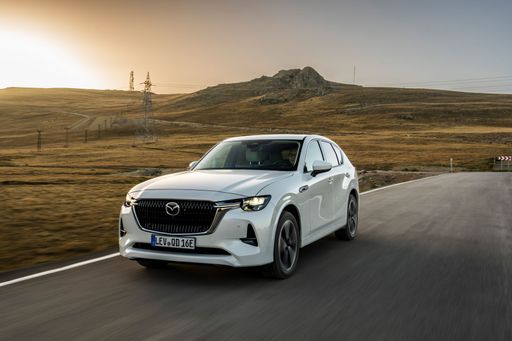 @ Mazda Motor Corporation
@ Mazda Motor Corporation
Mazda CX-60
Ford Kuga
The Kuga is Ford’s adaptable family SUV that blends usable space with a surprisingly lively driving character, making daily commutes and weekend escapes equally enjoyable. With smart interior packaging, an easy-to-use infotainment setup and composed road manners, it’s a sensible choice for buyers who want a bit of fun without the fuss.
details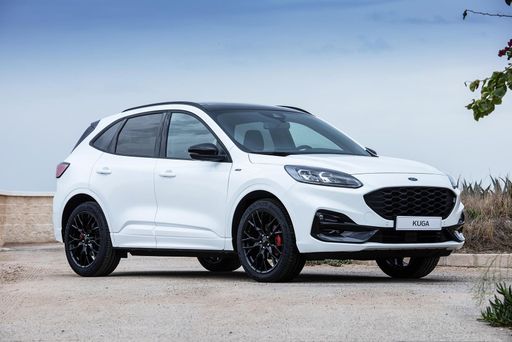 @ Ford Motor Company / Ford Media Center
@ Ford Motor Company / Ford Media Center
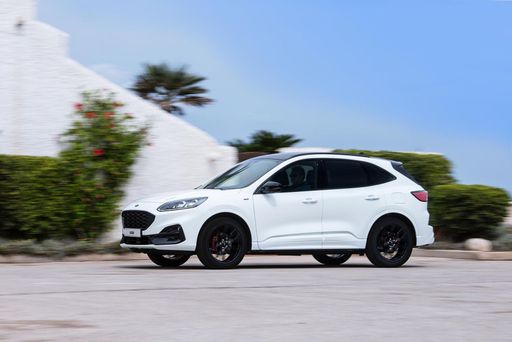 @ Ford Motor Company / Ford Media Center
@ Ford Motor Company / Ford Media Center
 @ Ford Motor Company / Ford Media Center
@ Ford Motor Company / Ford Media Center
Mazda CX-60
The Mazda CX-60 pairs sculpted, understated looks with poised handling and a cabin that punches above its class, making long drives feel unexpectedly civilized. For buyers who want a premium feel without the showroom swagger, it's the sort of car that earns respect quietly — and still manages a wink when you push on.
details @ Mazda Motor Corporation
@ Mazda Motor Corporation
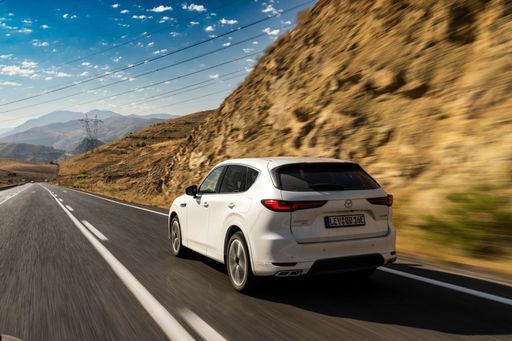 @ Mazda Motor Corporation
@ Mazda Motor Corporation
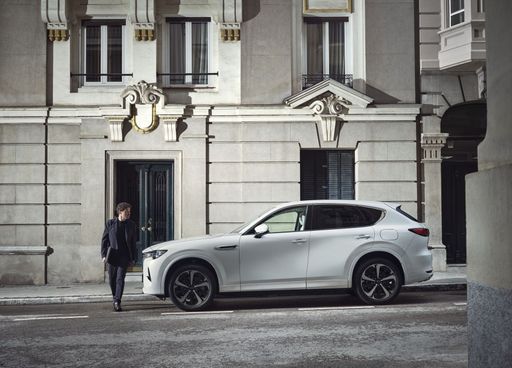 @ Mazda Motor Corporation
@ Mazda Motor Corporation
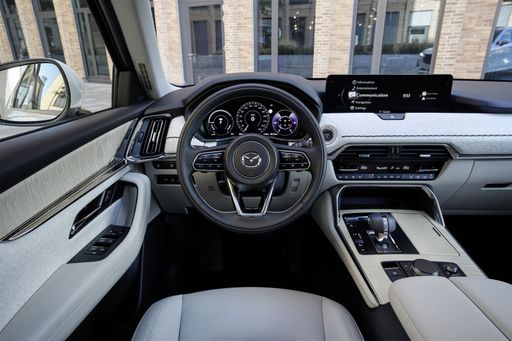 @ Mazda Motor Corporation
@ Mazda Motor Corporation
 @ Ford Motor Company / Ford Media Center
@ Ford Motor Company / Ford Media Center
|
 @ Mazda Motor Corporation
@ Mazda Motor Corporation
|
|
|
|
Costs and Consumption |
|
|---|---|
|
Price
34200 - 46300 £
|
Price
41900 - 56800 £
|
|
Consumption L/100km
2.8 - 6.8 L
|
Consumption L/100km
1.4 - 5.4 L
|
|
Consumption kWh/100km
-
|
Consumption kWh/100km
-
|
|
Electric Range
68 km
|
Electric Range
64 km
|
|
Battery Capacity
1.1 - 14.4 kWh
|
Battery Capacity
-
|
|
co2
55 - 154 g/km
|
co2
31 - 139 g/km
|
|
Fuel tank capacity
42 - 54 L
|
Fuel tank capacity
50 - 58 L
|
Dimensions and Body |
|
|---|---|
|
Body Type
SUV
|
Body Type
SUV
|
|
Seats
5
|
Seats
5
|
|
Doors
5
|
Doors
5
|
|
Curb weight
1526 - 1859 kg
|
Curb weight
1890 - 2055 kg
|
|
Trunk capacity
412 L
|
Trunk capacity
570 L
|
|
Length
4604 - 4645 mm
|
Length
4745 mm
|
|
Width
1882 mm
|
Width
1890 mm
|
|
Height
1673 - 1681 mm
|
Height
1680 - 1688 mm
|
|
Max trunk capacity
1534 L
|
Max trunk capacity
1726 L
|
|
Payload
541 - 550 kg
|
Payload
581 - 612 kg
|
Engine and Performance |
|
|---|---|
|
Engine Type
Petrol, Full Hybrid, Plugin Hybrid
|
Engine Type
Plugin Hybrid, Diesel MHEV
|
|
Transmission
Manuel, Automatic
|
Transmission
Automatic
|
|
Transmission Detail
Manual Gearbox, CVT, Automatic Gearbox
|
Transmission Detail
Automatic Gearbox
|
|
Drive Type
Front-Wheel Drive, All-Wheel Drive
|
Drive Type
All-Wheel Drive, Rear-Wheel Drive
|
|
Power HP
150 - 243 HP
|
Power HP
200 - 327 HP
|
|
Acceleration 0-100km/h
7.3 - 9.9 s
|
Acceleration 0-100km/h
5.8 - 8.4 s
|
|
Max Speed
195 - 200 km/h
|
Max Speed
200 - 219 km/h
|
|
Torque
240 Nm
|
Torque
450 - 550 Nm
|
|
Number of Cylinders
3 - 4
|
Number of Cylinders
4 - 6
|
|
Power kW
111 - 178 kW
|
Power kW
147 - 241 kW
|
|
Engine capacity
1496 - 2488 cm3
|
Engine capacity
2488 - 3283 cm3
|
General |
|
|---|---|
|
Model Year
2025
|
Model Year
2024
|
|
CO2 Efficiency Class
E, D, B
|
CO2 Efficiency Class
B, D, E
|
|
Brand
Ford
|
Brand
Mazda
|
What drivetrain options does the Ford Kuga have?
The Ford Kuga is available as Front-Wheel Drive or All-Wheel Drive.
The prices and data displayed are estimates based on German list prices and may vary by country. This information is not legally binding.
